R.J. Crayton's Blog, page 2
January 19, 2021
Life Imitating Art – Part II

I wrote a post not long ago about how the realities of the pandemic reminded me somewhat of the tales I’d written about people surviving a pandemic world. Yet, how they also differed in people’s reactions. As the Facebook meme suggested, “It turns out the expression, ‘Avoid it like the plague’ is wrong, because people don’t.”
While the aspect of virus deniers isn’t something I had anticipated, one thing I had written about was the notion of a person who was “immune” to the virus that scientists were studying in search of a cure. The main character in my virus series (Concealed, Exposed, Contained), Elaan is such a person, and she is being studied by scientists looking for a cure to the deadly virus ravaging the world.
So, I was quite intrigued when a ran across this story on an NBC news site, He unknowingly had Covid-19. Now his blood contains rare antibodies. Just like Elaan, this is is a man whose body is seemingly immune to the most harmful effects of the disease.The scientific nuance–per the article’s description–is different from my character. Whereas she cannot get the disease, this real-life person, Mr. John Hollis, actually did get COVID-19. Then his immune system went on the warpath and destroyed it. He felt a sniffle, and that’s it. According to the article:
“Hollis, 54, a former journalist, learned that his blood is fortified with so-called super antibodies — antibodies that neutralize the virus, which, even when diluted 10,000 times, still resists Covid-19, Liotta said.
It is a medical phenomenon found in less than 5 percent of the population who have contracted the coronavirus, a study indicates, making Hollis and his blood valuable resources in identifying potential treatments for Covid-19, Liotta said.”
So, his cells are brilliant and everyone wants cells like his. This is why researchers are studying him. The bad thing is that doctors think he was an early asymptomatic spreader, and gave the disease to his roommate. Interestingly, there are characters in Concealed who are asymptomatic spreaders, and they have such moral dilemmas about this. They feel extreme guilt over the idea that they could spread, but not get sick.
Yet, their guilt stems from the fact that they are a select few. In the Covid-19 pandemic, that guilt has been somewhat diffused by the fact that there are so many asymptomatic spreaders. By the fact that we don’t have good testing and so most people who are sick don’t know they’re sick and don’t know they are spreading. There is both extreme guilt and blame foisted upon those who knowingly spread Covid, going to parties knowing they’ve tested positive or getting on airplanes. There has been a public backlash against those who know, one that I think is reminiscent to those in my book.
Though, Concealed gets into some slippery slope issues of how do you treat someone who is unique in their asymptomatic spread. These concepts were based on Mary Mallon, better known as Typhoid Mary, who spread the deadly disease to 53 people as a carrier who was unable to get sick from the disease.
When Covid first came on the scene, they described it as novel, because we hadn’t seen it before. It’s novel, too, in that most diseases like this in the past have had effected those who get it similarly. If you get the flu, you know you have the flu and you feel sick. This disease brings that Typhoid Mary carrier vibe, yet diffuses it, because so many people are like Mary–seemingly unaffected themselves–but bringing blight to those the come into contact with.
As usual, it’s so strange to see parallels between life and fiction. The good news is that life seems to be doing so much better than my fiction, set in the throws of despair. At least, here in the real world, we have a vaccine. The roll out has been slower than expected, but it is coming. And that is good news. I love that real life scientists worked better and faster than the ones in my book and they got it done. If I write about viruses again, art will definitely imitate life.
Take care.
-RJ
January 5, 2021
Ready for the new year

Thankfully, 2020 is one for the history books. We’ve left that horrible year behind us and are now charting our course for what we want to be an improved year.
And here’s the thing: if we want this year to be better than last we have to go Picard-esque and make it so. No one predicted a pandemic last year, and once it set in, many of us did all that was within our power to make the best of it. But there are those who didn’t. Those who denied, those who still deny.
This year needs to be a year of putting in the effort to make good things happen. To take a moment to put our best foots forward, and to really make it a good year. We need to exercise compassion, and ask folks to forget about what happened last year–as best they can–and help us move forward to make this year better. We have a vaccine, which will help, but we need it distributed (which hasn’t been happening well, so far).
The good news is I have faith that competent people are coming in to do good work. And that we will get the vaccine distributed as it becomes more readily available (in terms of supply). And as we get more vaccination and return to life that more closely resembles pre-pandemic, I hope we will remember the resiliency we learned in 2020. For those who were able to boost their morale, hunker down and get stuff done, kudos. For those who struggled, who fell behind, who could not cope, that’s alright. This has been a tough year. You are still here. Help is available. You are loved, and know that you can get through this.
This year, I want to reach out to those I love more. It’s been hard not seeing people, so I really want to see people more once the vaccine is widely available. I want to visit parents and siblings and really see people. I’ve got an extra week of vacation to carry over because I hardly used any last year, so I want to squander it on frivolous trips to see people, just because.
And in 2021, I hope to write more on my novels. For me, output wise, 2020 was a loss. And while it’s not what I had intended, it can’t be changed now. The good news is I can forge ahead and figure out what I want to write and write it. I have a lot of ideas in my head, so I will have to set a course soon.
How about you? What is on tap for you for 2021 to make it better than 2020?
December 4, 2020
The Realities of Long-Term Pandemic Life

We’re going on the 10th month of being in a pandemic and I thought I’d take a moment to reflect on that, especially since several of my books look at worlds following or during a pandemic.
The long-term view of living with a pandemic is so different than what I would have imagined. It never would have occurred to me that people would deny a deadly disease. Though, the pandemics I imagined in fiction were horrifically more vicious than COVID-19, with mortality rates in the 80th percentile. It has been shocking and disturbing that deadly disease has become politicized to the point that people discount the deaths of hundreds of thousands of people as weak citizens.
Though, the reality of it does show just how diverse humanity is, how truth can be stranger than fiction. Society doesn’t always behave as you would expect it to. In my thoughts of a pandemic life, I never thought of deniers, people seeing disease kill, but refusing to believe it was a problem. Yet, here we are.
There is an isolation to being in a pandemic like this, because there is so much that society is doing to fight it off. And I think that resiliency and cleverness is good. When we write, or even read, books about dystopias, so much of it is close and insular. So much of it is a few group of people who are making decisions. But stories are like that. They’re insular. In a real pandemic, there are so many things going on at once. As you leave your insular bubble, you realize just how different things are. Technology has allowed us to hear other stories. People in mask-heavy areas can hear from Facebook friends about how their area is.
The other thing that was unexpected was just how wary one begins to feel after months of exile and strange living. Not going to school or work or other normal things–seeing family–is very negative for the soul. The constraints of having to be physically distant from most people is hard. As human beings, we’re fairly communal, so it doesn’t feel natural. I miss the typical activities and the camaraderie and the normal activities. I’m sure it’s very hard for those who are in healthcare, who are surrounded by people getting sick and dying.
The good news is that as hard as it has been, we are so much luckier than people in previous pandemics. The bubonic plague lasted not just a year, but several. And there was no clear knowledge on how to avoid or treat their disease. At least modern medicine has some arrows in its quiver when it comes to fighting the disease. And the good news most recently is that we have positivity on the vaccine front. While it’s still a few months away, it’s a good sign that gives hope.
When the pandemic closures began back in March, I certainly never thought it would last this long. I thought we’d have two months of quarantine and get back to our lives (like China did). Yet, here we are 10 months later. It’s been quite an experience, but one I would never want to repeat. I hope, as a society, we have learned important lessons about plagues. I hope we’ve learned important lessons about how to aid our fellow man, even if they are not together. And more importantly, I hope that once the coronavirus is under control, that we don’t have another plague like this for many decades.
So, where are you at, after 10 months of pandemic life?
November 25, 2020
Finding gratitude in a miserable year.
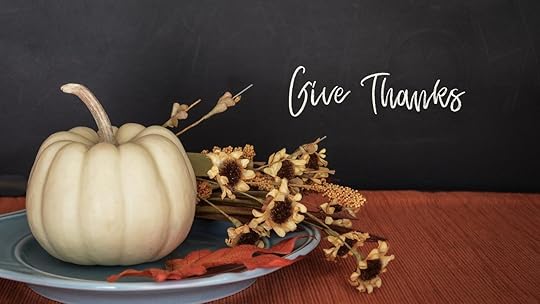
It’s almost Thanksgiving here in the U.S., which means many folks will be thinking about the things they have to be thankful for. In a normal year, that’s an easy task for many. In a year like 2020, one filled with a global pandemic that has sickened millions, killed a quarter of a million, and forced tens of millions out of work, that may be a tougher order.
That doesn’t mean we’re not up to the task, though.
2020 has been brutal. But, luckily, so many of us are resilient. So many of us have found a way to survive it. Some have even thrived in it. For all those folks who have made it through and can find something to be thankful for, kudos to you.
For those who have had a hellish year and see only the losses, only the things that have been taken from you, only the negativity, I hear you. It has been too much, in so many instances. Much too much. A well of darkness. While that is true, try to remember that it ain’t over until it’s over. There is still the better part of a month left in 2020, and in that, there is hope. It is why we read stories and why we love them: because there is always hope.
And stories are art imitating life, not the reverse. This darkness that has felt encompassing can pass. Will pass. Light will come back. We just have to give it some time. And lean on those we love in the mean time.
I wish you all a Happy Thanksgiving.
November 1, 2020
What is Your Embellished Story?

Recently, I cast my ballot in the election. I had opted to vote by mail back in July, thinking that would be easier in the pandemic than voting in person.
While I now think voting in person may have been the better way to go, my state doesn’t allow you to change your mind (you get a provisional ballot if you go in person after requesting an absentee ballot). Knowing that, I decided to use a dropbox, and since the dropbox wasn’t super far from my house (just 2 miles), I decided to walk.
Only the morning I was going to walk, it was raining. And when the rain finally slowed, I decided I would walk through the mist and fog and have a wonderful story to tell my future grandkids about how I walked 4 miles through fog and rain in a face mask, uphill both ways, to cast my ballot during the 2020 election.
I mean, if you can goose up your story, why not? As my husband’s grandmother used to say, whenever someone made a correction to her story, “It sounds better if I tell it this way.” Then she’d wink.
So, what is your best embellished story? And you don’t even have to tell what part is embellished. Just the tale. We want to hear a juicy one.
October 28, 2020
How Halloween Reminded Me of Key People Managing Lessons
No, you’re not at the wrong blog. Managing people is not something I usually write about. However, when I’m not writing novels, I do a fair amount of reporting on business and HR (as in human resources) issues.
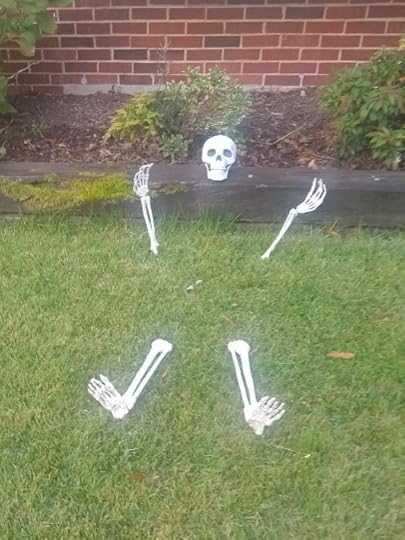
I’ve read more than my fair share of articles on how it’s important that all staff understand the business goal, feel like they are responsible for the image the organization shows, and feel empowered to make decisions.
When I finish working, I don’t necessarily think of my home in a business sense or my children as staff. However, when it came to Halloween decorating, I could have used this mindset. The picture is the skeleton that we got as a yard decoration. Awesome, right? Very creepy and full of the Halloween spirit (hopefully figuratively and not literally).
It’s five pieces (two arm bones, two leg bones, and a skull), each attached to a spike you plant in the ground. After we bought it, I told my children to put it anywhere in the yard that they wanted.
I gave them those directions and nothing more. Management experts will tell you that is where I made the mistake. Because all I did was give them a simple instruction with little guidance. While I verbally told them to put it anywhere they wanted to, in my mind, I was saying, “Put it anywhere that makes sense.” I didn’t say, you need to look at the yard as a whole when you finish and make sure this looks appropriate.
I did not expressly tell them they could move other things in the yard. That would have made sense, as there was something else in the yard (we’ll get to that in a second). While I assumed that they would feel empowered to move things as needed, I didn’t say they had permission to move things. I also didn’t assure them they could ask me questions if they had any. Finally, as the mangaement experts will tell you, I didn’t make sure we were all clear on the goal–to make the yard look both festive for Halloween and appropriate.
So, about three hours after given the task to place the skeleton in the yard, I happened to wander outside to discover this:
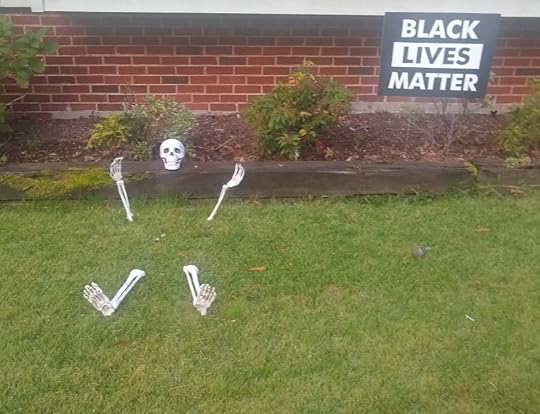
Oh my! You see, social justice signs and Halloween displays do not mix. One might get the impression that despite the sign, we do not, in fact, believe that Black lives matter. That skeleton absolutely casts doubt on the sign.
I immediately moved the sign to the other side of the yard, and hoped not too many people saw the display together. This, my friends, would be a management fail in anyone’s books. The Black Lives Matter has been in the yard since early summer, and I hadn’t really thought about the fact that it was in the yard until I saw the two together. But clearly the kids didn’t feel empowered to move things or make executive decisions about the overall look and feel of the yard.
After I took the picture, had a talk with the children, who did actually recognize the skeleton might be too close, but weren’t sure what to do. Clearly, I should have reminded them to let me know if they had any questions.
So, from now on, I’m going to give a little more management think through to tasks assigned to the child staff. Clear goals are a must, along with clear expectations that they’re empowered to make certain decisions.
I’m good until Halloween is over, but the next obvious question is, How do Black Lives Matter signs fit with Christmas decorations?
October 24, 2020
Facebook’s Bias and Shaming of Breast Cancer Survivors By Blocking Posts
Facebook has long been accused of bias in its algorithms and despite claims that they are trying to improve things, it never seems to get better.
The latest case in point is my own experience on Facebook the other day. I saw an article about Rihanna’s Fenty clothing line using breast cancer survivors, some of whom were proudly showing scars left from their cancer, modeled her clothing. I posted this on Facebook, only to have it removed from view, and told I violated the community standards for nudity. Here’s the thing though. It doesn’t. Here’s a screenshot of my post and a screenshot of their community standards (both taken on my phone).
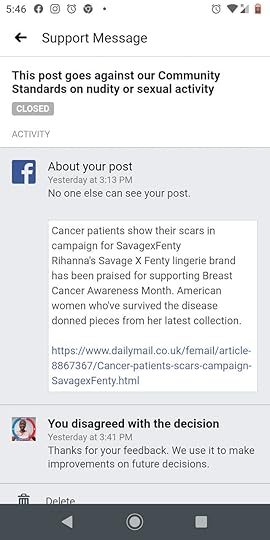
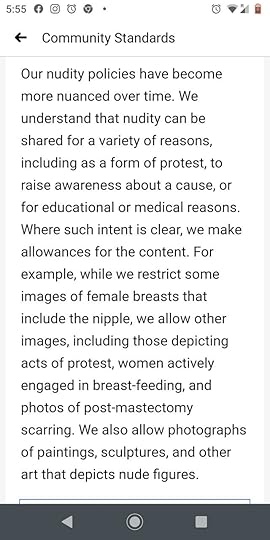
So, for those using a screen reader, the left is a picture of Facebook blocking the article: (headline) Cancer patients show their scars in campaign for SavagexFenty; (subhead) Rihanna’s Savage X Fenty Lingerie brand has been praised for supporting Breast Cancer Awareness Month. American women who survived the disease donned pieces for her latest collection. The Facebook message says “This post goes against our Community Standards on nudity or sexual activity.”
The screenshot on the right is from Facebook’s Community Standards page and says, “For example, while we restrict some images of female breasts that include the nipple, we allow other images, including those depicting acts of protest, women actively engaged in breast-feeding, and photos of post-mastectomy scarring. We also allow photographs of paintings, sculptures, and other art that depicts nude figures.”
So, the pictures of the black women who had scarring was not in fact in violation of their policy. Despite my appeal, Facebook continued to suppress my post and sent me a note saying my account would be suspended if I violated their policy again. Despite the fact that Facebook regularly obscures images, offers a warning that some may view it as inappropriate or triggering, and requires you to click on the image to see it, it didn’t choose to do any of these things. It chose to block the posting of a good news story and threaten me.
This is problematic behavior for multiple reasons. First and foremost, breast cancer is a horrific disease that plagues too many women. Too many women die, leaving behind holes in the hearts of their friends and families. Those who survive, who fight through chemo, radiation, surgery, and other treatments deserve respect and grace. And when Facebook suppresses stories about survivors, it dishonors all breast cancer patients. It makes it seem as if their scars are something they should be ashamed of, rather than the mark of their battle they fought hard and were fortunate enough to win. Suppressing these post—particularly in the heart of Breast Cancer Awareness Month—especially dishonors those fighting the disease and looking for inspiration to help them through treatments that are often grueling and soul crushing.
The second problem with the removal of this post is racial bias. The women pictured in the article were black breast cancer survivors. I am also a black woman and Facebook has a history of silencing posts by black people. USA Today wrote an article about the practice, known as “getting Zucked.” While the article talked primarily about mislabeled hate speech, the same algorithms that discriminate against black people for hate speech can discriminate against Black people in other areas. Additionally, there is evidence that facial recognition software is designed to detect white skin and does poorly with darker skin tones. And while faces are nuanced in many ways the rest of the body isn’t, it’s not clear to me that software designed to recognize body parts wouldn’t have the same problem with identifying properly black mastectomy survivors with scars? Did the algorithm even read the headline or content of the article?
There is also evidence that racism and sexism get programmed into algorithms. And if there was an initial error, then there should be an easy way for a human to correct it. However, my disagreement that it did not violate their standards was reviewed (I do not know if it was by a person or a machine) and then I was told I was wrong. That’s not right.
The problem is, despite many calls from activists within the breast cancer community and the Black community, Facebook can’t get it right. The ACLU continues to fight for those harmed by Facebook’s bias, but it shouldn’t take a fight. They must do better.
The only people who don’t need to do any better are those living with and battling breast cancer. They are doing their all and more, and I salute them. Those who are brave enough to show us your scars, I will always promote you and honor you. You have nothing to be ashamed of. To women who have survived with or without scars, you have nothing to be ashamed of. To anyone who wants to share those stories, you have nothing to be ashamed of. Share loud and proud, with or without pictures.
The only people who should be ashamed work at Facebook.
Facebook’s Bias and Shaming of Breast Cancer Survivors By Blocking Posts
Facebook has long been accused of bias in its algorithms and despite claims that they are trying to improve things, it never seems to get better.
The latest case in point is my own experience on Facebook the other day. I saw an article about Rihanna’s Fenty clothing line using breast cancer survivors, some of whom were proudly showing scars left from their cancer, modeled her clothing. I posted this on Facebook, only to have it removed from view, and told I violated the community standards for nudity. Here’s the thing though. It doesn’t. Here’s a screenshot of my post and a screenshot of their community standards (both taken on my phone).


So, for those using a screen reader, the left is a picture of Facebook blocking the article: (headline) Cancer patients show their scars in campaign for SavagexFenty; (subhead) Rihanna’s Savage X Fenty Lingerie brand has been praised for supporting Breast Cancer Awareness Month. American women who survived the disease donned pieces for her latest collection. The Facebook message says “This post goes against our Community Standards on nudity or sexual activity.”
The screenshot on the right is from Facebook’s Community Standards page and says, “For example, while we restrict some images of female breasts that include the nipple, we allow other images, including those depicting acts of protest, women actively engaged in breast-feeding, and photos of post-mastectomy scarring. We also allow photographs of paintings, sculptures, and other art that depicts nude figures.”
So, the pictures of the black women who had scarring was not in fact in violation of their policy. Despite my appeal, Facebook continued to suppress my post and sent me a note saying my account would be suspended if I violated their policy again. Despite the fact that Facebook regularly obscures images, offers a warning that some may view it as inappropriate or triggering, and requires you to click on the image to see it, it didn’t choose to do any of these things. It chose to block the posting of a good news story and threaten me.
This is problematic behavior for multiple reasons. First and foremost, breast cancer is a horrific disease that plagues too many women. Too many women die, leaving behind holes in the hearts of their friends and families. Those who survive, who fight through chemo, radiation, surgery, and other treatments deserve respect and grace. And when Facebook suppresses stories about survivors, it dishonors all breast cancer patients. It makes it seem as if their scars are something they should be ashamed of, rather than the mark of their battle they fought hard and were fortunate enough to win. Suppressing these post—particularly in the heart of Breast Cancer Awareness Month—especially dishonors those fighting the disease and looking for inspiration to help them through treatments that are often grueling and soul crushing.
The second problem with the removal of this post is racial bias. The women pictured in the article were black breast cancer survivors. I am also a black woman and Facebook has a history of silencing posts by black people. USA Today wrote an article about the practice, known as “getting Zucked.” While the article talked primarily about mislabeled hate speech, the same algorithms that discriminate against black people for hate speech can discriminate against Black people in other areas. Additionally, there is evidence that facial recognition software is designed to detect white skin and does poorly with darker skin tones. And while faces are nuanced in many ways the rest of the body isn’t, it’s not clear to me that software designed to recognize body parts wouldn’t have the same problem with identifying properly black mastectomy survivors with scars? Did the algorithm even read the headline or content of the article?
There is also evidence that racism and sexism get programmed into algorithms. And if there was an initial error, then there should be an easy way for a human to correct it. However, my disagreement that it did not violate their standards was reviewed (I do not know if it was by a person or a machine) and then I was told I was wrong. That’s not right.
The problem is, despite many calls from activists within the breast cancer community and the Black community, Facebook can’t get it right. The ACLU continues to fight for those harmed by Facebook’s bias, but it shouldn’t take a fight. They must do better.
The only people who don’t need to do any better are those living with and battling breast cancer. They are doing their all and more, and I salute them. Those who are brave enough to show us your scars, I will always promote you and honor you. You have nothing to be ashamed of. To women who have survived with or without scars, you have nothing to be ashamed of. To anyone who wants to share those stories, you have nothing to be ashamed of. Share loud and proud, with or without pictures.
The only people who should be ashamed work at Facebook.
October 16, 2020
How Are You Faring?
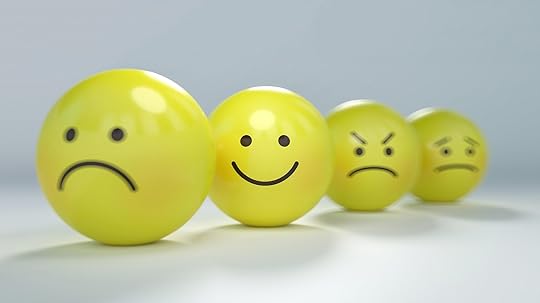
We’re more than six months into the shut downs from the pandemic and the continued masking and distancing. While safety is crucial, it can be warying to be restricted for so long.
I’ve become quite fatigued of all the COVID restrictions, and while I do them, I’m looking for ways to still be active while being safe. We went to an apple orchard a few weeks ago. I, reluctantly, took my daughter to Six Flags (open air, masks required, lots of hand sanitizer), and we’ve been out walking and biking tons. But I have to admit it’s hard being so out of the norm of what life has been for the first decades of my life.
I would love for them to get the testing capacity improved. There are several stories about the usefulness of fast tests that offer quick results of whether or not you’re infectious. With widespread quick testing, we’d really be able to get a hold on the pandemic, and tamp it down. When people don’t know if they’re sick, it’s too easy to spread.
Unfortunately, it doesn’t look like there’s a lot of movement on quick testing, so we’re going to be going through this much of the winter.
Right now, I’m fatigued, more so for my children than myself. Virtual school is hard. It’s hard not to see your friends, and kids don’t have the same perspective as adults. They view this as lasting forever. And while I know it won’t last forever, when you think about the amount of life a child remembers (usually they cement memories from age 7 on, with some getting bits and pieces), a year of their life (how long this pandemic will probably last at a minimum) is huge percentage-wise. A kid who is 14, with just 7 years of real memory would feel like they’d spent one-seventh of their life enduring this. That’s a long time. And it feels even longer.
So, right now I’m steeling myself for longer, but very frustrated at the lack of progress. How are you feeling?
May 9, 2020
It’s OK to Mourn What Was Lost
Since this pandemic has began, people have talked a lot about the new normal.
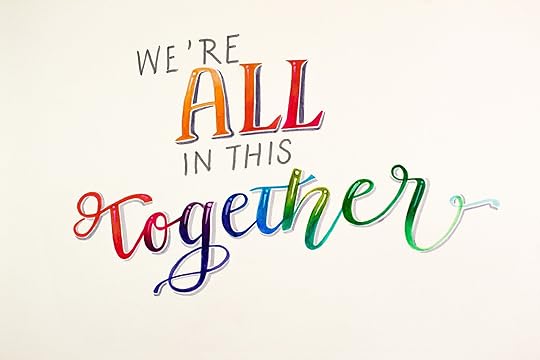 Source: Pixabay
Source: PixabayThis is a tacit acknowledgment that the world we once had, the way of life we once accepted as normal has left us. The ability to walk freely from place to place, to gather with friends and family, to go to work in a “normal” fashion was taken away from most of us by the pandemic.
And that is sad and frustrating. Some people cope by making the best of a bad situation, others cope by making a situation worse so they can feel like they have control over something in a situation that is beyond their control.
Change is scary, and that’s why people resist it. We don’t want to be thrust into this new normal. Especially when it’s much worse than what we had.
But sometimes life is like that. And while nobody likes it, the strength of human beings is being able to look forward, to look for solutions to our problems, to improvise until we find something that works, and to keep moving forward.
And while we have to move forward, it’s OK to take time to mourn what we’ve lost and acknowledge how it’s changed us. We have changed. We have lost the sense of safety and security that we once had. Some have lost loved ones. Some didn’t get to say goodbye. Some have lost jobs. Almost all have lost their daily routines.
It is a lot. And it happened quickly and drastically and, for many of us, with little warning. If some days you don’t feel like moving forward, it’s OK to acknowledge that. It’s OK to give yourself a break as you figure out how to cope.
The good news is, we are all learning together. Reach out to people if you need help. Not all will reach back (unfortunately, these situations can bring out selfishness and cruelty), but many people will reach back. The best of humanity reach out to others and lend a helping hand. And a kind word. And sometimes that is just what we need to help us move forward.



